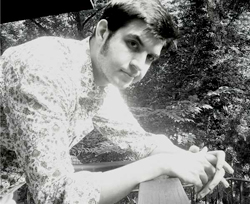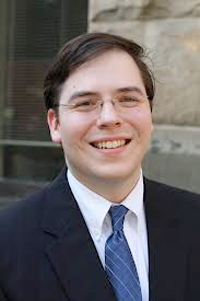by Mike Telin

A highlight of the project will take place on Wednesday, March 12 in Fairmount Presbyterian Church, when CityMusic under the direction of James Feddeck presents the premiere of Dan Visconti’s percussion concerto, Roots to Branches. The work was commissioned by CityMusic especially for this project and features Grammy-winning percussionist Shane Shanahan and narrator Ali Alhaddad. The program also includes Chinary Ung’s Khse Buon for solo cello with James Jaffee as soloist, and Beethoven’s Symphony No. 3, “Eroica.” Performances continue through Sunday at area churches.
Dan Visconti says the project is “a great social engagement project that is in keeping with CityMusic’s mission. Cleveland was built on the stories of immigrants, and today’s diverse refugee populations likewise tell tales of escaping persecution.” In addition to a Rome Prize, Visconti has been awarded a 2014 TED Fellowship for his “ongoing initiatives innovating concert experiences that address social issues through music.”
“It’s an amazing project,” says James Feddeck. “I think that CityMusic taking on a project like this that is so much about the fabric of the city and what it means for so many people is thrilling. I hope the masses turn out because it’s going to be an amazing week on many levels.”
Both Visconti and Feddeck give high credit to the thoughtful and sensitive community engagement work done by Rebecca Schweigert Mayhew, who dedicated so much time getting to know various refugee communities from Bhutan, Burma, Burundi, Congo, Iraq, Nepal, Russia, Somalia and Sudan. “There is enormous pressure on the refugees to assimilate, learn English and become Americanized,” said Mayhew, adding that we all need to remember that the language, art, dance and music refugees bring with them is part of Cleveland’s rich cultural fabric.
“In a project like this it was very important to be respectful of the different musical traditions of the individual cultures,” said Visconti, who added that one of the great things about composing the piece was the wonderful experience of learning those traditions. “I worked with Rebecca closely. She really helped me a lot by taking me to meet some of the people. I was inspired by their stories but I was really surprised by how much humor there was in our conversations.”
“I think what Rebecca has done is amazing, and this project is a whole eye-opening experience for me,” said Feddeck. The way the city has been a real home away from home for so many people and that Cleveland is a place that has brought a sense of belonging to so many is incredible.”
In addition to hearing the stories of the different refugee groups and learning about each group’s music, Visconti was faced with another task: finding the right percussionist to perform his work. “Dan found me online and sent an e-mail though my website,” said Grammy-winning percussionist Shane Shanahan. “I’m not sure if someone had recommended me or exactly what the connection was but my first introduction to him was his e-mail.” Shanahan, who studied western classical music as well as the drumming traditions of many cultures, has been a member of Yo-Yo Ma’s Silk Road Ensemble since 2001. “I think one of the things that interested him was the diversity of my interests which seemed like a good match for the project.” Shanahan was recently named Chair of Silk Road Project’s Leadership Council and continues to serve as the ensemble’s Lead Teaching Artist for the education initiative Silk Road Connect.
“Dan came to my studio in Brooklyn and I gave him a tour of all of the instruments that I have, which include a lot of hand percussion, melodic percussion and some of the flutes that I’ve been getting into more recently,” recalled Shanahan. “We also talked about notation because some of the instruments don’t have a standardized notation.”
Based on that visit, Visconti chose the instruments he thought would work and soon Shanahan began receiving the parts as sections of the piece became available. “Dan’s been in Italy and we’ve been communicating via Skype, so when I would come across something in the score that I had a question about we would connect and talk though it. I gave some suggestions on the different possibilities in terms of setup that might make certain things easier. Subtle changes here and there. Dan was also interested in what I had to bring to the table so there is room for some improvisation.”
Visconti said the title of the concerto, Roots to Branches, comes from a quote from an interview with a local Bhutanese refugee:“I have lost my roots but gained many branches; my family tree flowers once again with the promise of opportunity, and in my turn my greatest hope is to give back to this great country that has given my family a new chance to blossom.”
After toying with several approaches to structuring the piece, Visconti’s first thought was to assign a movement to a story or cultural identity. “Instead I decided to organize the concerto’s narrative in light of the many common points of reference that all the refugees interviewed for this project seemed to experience and blend them together.” These shared experiences include: frustration in the homeland; the feeling of limbo in the refugee camps – never knowing what was going to happen next; the ways the people arrived in the United States (for example boat or plane); the challenges people faced once they did arrive in Cleveland, and the reconciliation of what they had experienced.
Roots to Branches, which lasts roughly 20 minutes, is a work in five movements plus prologue. The various instruments include two flutes, Indian and Chinese, and two melodic percussion instruments, kalimba, an African thumb piano and a metal tongue drum, which Shanahan says produces “a pretty cool resonant sound.” Other instruments Shanahan is called upon to use are various drums from Africa and the Middle East, and some Indian and Japanese temple bowls.
Although the first rehearsal had not yet taken place at the time of our conversation, conductor James Feddeck said he could easily tell from the score that the piece is very colorful. “There is an enormous landscape of color between the orchestra and the soloist. I think Dan uses the orchestra beautifully to weave all of the instrumental sonority into the percussion writing. And I think the narration is a very nice touch because it gives context to the music. It’s all very interesting.”
Feddeck likes the idea of beginning an orchestra concert with Chinary Ung’s Khse Buon (Four Strings), for solo cello, a “brilliant” idea he credits to CityMusic executive director Eugenia Strauss. “I think it’s very fitting. It’s like the single voice, a voice that’s trying to find its way, so it’s very poetic for this particular concert. I am interested in discovering what the Beethoven will be like after Dan’s piece because I do think it will color how we hear the symphony. In this context you really are talking about the ideas of freedom that Beethoven had. We’ll all be experiencing that through this narrative. Everything that Rebecca put together is going to illuminate the Beethoven in such a different light. And I would suppose in a more appropriate light then the usual overture — concerto — symphony format.”
Published on ClevelandClassical.com March 10, 2014
Click here for a printable version of this article.





